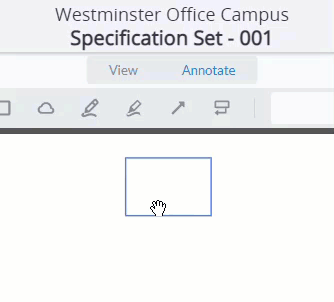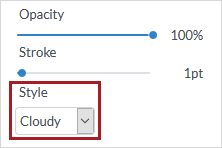Search tips
- To search in a subset of topics, select
 in the search field and select a filter.
in the search field and select a filter. - To search for a specific word or phrase, add quotation marks around it (example: "budget column") in the search field.
- To remove highlighting on the search terms in a topic, select
 .
. - To search within a topic, select
 , press Ctrl+F, and enter the search term.
, press Ctrl+F, and enter the search term.
You can add different types of annotations to a specification or specification set and link items to them. The name of the annotation tool is displayed when you hover over it on the toolbar.
Annotations can't be added, edited, or removed in published specifications in the Specification Sets module. However, you can add, edit, and remove the annotations in the specification viewer.
When a new revision is uploaded in specification set, the annotations from the published current version are carried over to the corresponding pages in the revision and are marked for review.
- Select the annotation.
You may need to select the border of the annotation.

Opening the Annotation menu
- If the Layers panel is closed, select
(Layers) on the navigation toolbar.
- Ensure that the Show annotations toggle is on.
- To hide the public or private annotations, turn off the Show public annotations or Show private annotations toggle.
- In the Records section, filter the annotations based on linked records.
- Record types: The record types that you have access to.
- Status: The statuses for the record types that you have access to. This list is filtered based on the selected record types.
- Assigned to contact: The project contacts with open assignments for linked records that are unlocked.
- Assigned to company: The companies of the project contacts with open assignments for linked records that are unlocked.
- In the Annotations section, filter the annotations by their properties.
- Type: The annotation types.
- Color: The stroke and fill colors from the Annotation toolbar and Annotation menu. If the stroke and fill colors of an annotation are different, the annotation is displayed when you select either color.
- Created by: The users who added annotations that are visible to you. Your name is included even if you haven't added any annotations yet.
- To hide the labels for linked records, turn off the Show annotation labels toggle.
- To hide the linked or unlinked annotations, turn off the Show linked annotations or Show unlinked annotations toggle.
- An annotation must meet all the selected filters to be visible in the specification set or specification.
- If you select any filters in the Records section, any annotations that are unlinked or linked to other items such as drawings are hidden.
- The selected filters are applied as new annotations are added or linked records are updated. If an annotation disappears, you can select Remove applied filters to see all the annotations.
- All the items in the Links panel are available even when the linked annotations are hidden.
- The selected filters are still applied when you select
(Previous) or
(Next) to navigate to another specification set or specification.
- At the bottom of the specification set or specification, select Remove applied filters.
—Or—
In the Layers panel, select Reset filters.
The visibility of an annotation depends on who added the annotation, whether it's public or private, and what it's linked to. You can see an annotation if:
- It's an annotation that you added to the specification or specification set.
- It's an unlinked public annotation.
- It's a public annotation that's linked to an item that you have access to.
In a specification or specification set, you see the following annotations:
- A private annotation that you added and linked to a file.
- A public annotation that another user added and linked to an RFI that you have access to.
You don't see the following annotations:
- A private annotation that another user added.
- A public annotation that's linked to a draft record created by another user.
- Select the annotation.
- On the Annotation menu, turn the Public toggle on or off:
-
 (Public)
(Public) -
 (Private)
(Private)
If you don't have permission to create and modify public annotations, you can make your own annotations public by linking them to a record. To make the annotation private again, you can unlink the record.
The toolbar contains tools for adding annotations.
| Button | Name | Description |
|---|---|---|

|
Annotation tools | Display the annotation tools. |

|
Underline | Underline the text. |

|
Highlight | Highlight the text. |

|
Squiggly | Add a squiggly line to the text. |

|
Strikethrough | Add a strikethrough to the text. |

|
Rectangle | Add a rectangle. |

|
Free Text | Add a text box. |

|
Free Hand | Draw a freehand line. |

|
Note | Add a note. |

|
Arrow | Add an arrow. |

|
Cloud | Draw multi-sided cloud. |

|
Callout | Add a callout. |

|
Color | Select a color for the annotation. These buttons change based on the selected annotation. |

|
Style | Open the Style panel. The style options depend on the type of annotation. |

|
Undo | Undo the last action. |

|
Redo | Redo the last action. |

|
Eraser | Erase an annotation. |
You can add different types of annotations to a specification. The name of the annotation tool is displayed when you hover over it on the toolbar.
Some annotations use a default style, but you can select a different style. You can't set the default styles, but your current selections are used as long as you open specifications in the same tab and module. After you open another specification in a new tab or navigate to a different module and then open a specification, the annotations use the default styles again.
Some annotation tools remain active until you select  (Select) or press Esc.
(Select) or press Esc.
- On the toolbar, select
 , and then select the Free Hand or Arrow tool.
, and then select the Free Hand or Arrow tool. - To draw the line, do one of the following:
- Free Hand Highlight or Free Hand: Select the specification and draw the line. There's a brief delay before the annotation is created so you can draw multiple lines.
- Arrow: Select the specification and draw the line.
A note is added to the Comments panel when the annotation is created. If you select (Save) before that happens, the annotation isn't saved.
- On the toolbar, select
 , and then select the Rectangle or Cloud tool.
, and then select the Rectangle or Cloud tool. - To draw the shape, do one of the following:
- Rectangle: Select the specification and draw the shape.
- Cloud:
 Draw the first side, and then add the other sides.
Draw the first side, and then add the other sides.
- On the toolbar, select
 , and then select the Callout tool.
, and then select the Callout tool. - Select the specification, draw the first side of the callout arrow, and then select again for the endpoint.
- Draw the other side of the callout arrow, and then select for the endpoint.
- Enter the callout text.
- On the toolbar, select
 , and then select the (Free text) tool.
, and then select the (Free text) tool. - Select the specification, and draw the text box.
- Enter the text.
—Or—
Select the specification to place the text box.
- On the toolbar, select
 , select the text tool, and then select the text on the specification.
, select the text tool, and then select the text on the specification.
—Or—
Select  (Select), select the text, and then select an option on the menu.
(Select), select the text, and then select an option on the menu.

You can add notes and replies to annotations.
- On the toolbar, select
 (Comments).
(Comments).
- In the Comments panel, select Filter, and then select the filters.
- Select Apply.
- In the Comments panel, select an option:
- Position: Sort the notes by the order (top to bottom) that they appear in the specification.
- Created Date: Sort the notes by the date that they were created.
- Modified Date: Sort the notes and replies by the time that they were modified.
- Status: Sort the notes by the status.
- Author: Sort the notes the author's name.
- Type: Sort the notes by the annotation type.
- Color: Sort the notes by the annotation color.
- On the toolbar, select
 >
>  (Note).
(Note). - Select the specification in the viewer to place the note.
- In the Comments panel, enter your comment, and then select Save.
The icon changes to the default color. You can also change the color from the Style menu.
You can also select an annotation and then add a note in the Comments panel.
- In the Comments panel, select the note.
- At the top-right of the note, select the status icon, and then select a status.

- In the Comments panel, select the note.
- Enter your comment in the reply field, and then select
 (Post).
(Post).
- In the Comments panel, select the note.
- In your reply, select
 > Edit or Delete.
> Edit or Delete. - You can only edit but not delete the first note of an annotation.
- If you have permission to add and modify notes and replies for public annotations, you can edit the first note that you or another user added. Otherwise, you can only edit the first note that you added.
- You can only edit and delete your own replies to the first note of an annotation.
You can edit public annotations, if you have permission to do so, and your own annotations.
- Select the annotation.
- On the Annotation menu, select
(Style).
- Do any of the following:
- To change the color of an annotation, select a color. Depending on the type of annotation, you can select a color on the Text, Stroke and Fill tabs.
- To adjust the opacity of an annotation, select and move the Opacity slider.
- To adjust the stroke width of a line annotation, select and move the Stroke slider.
- To adjust the text of an annotation, modify the options on the Text tab.
- To change the line style of a shape annotation, select an option from the Style list.

Style tabs that may be available for an annotation

- Select the annotation.
- To move the annotation, select and drag the middle of it.
- To resize the annotation, select and drag a sizing handle.

If a large annotation overlaps with a smaller annotation, the smaller annotation is selected when you click the annotation area. To select the larger annotation, click an area that doesn't overlap with the smaller annotation.
You can delete public annotations, if you have permission to do so, and your own annotations.
- Select the annotation.
- On the Annotation menu, select
(Delete).
—Or—
Press the Delete key.

